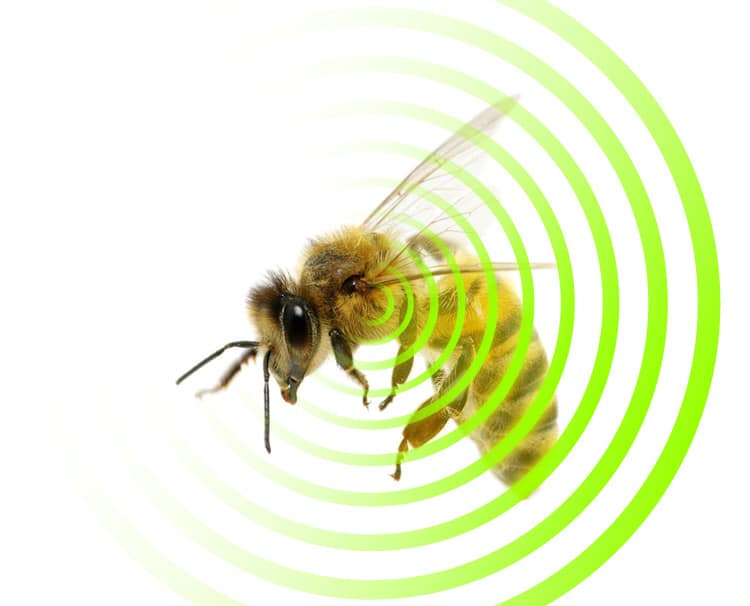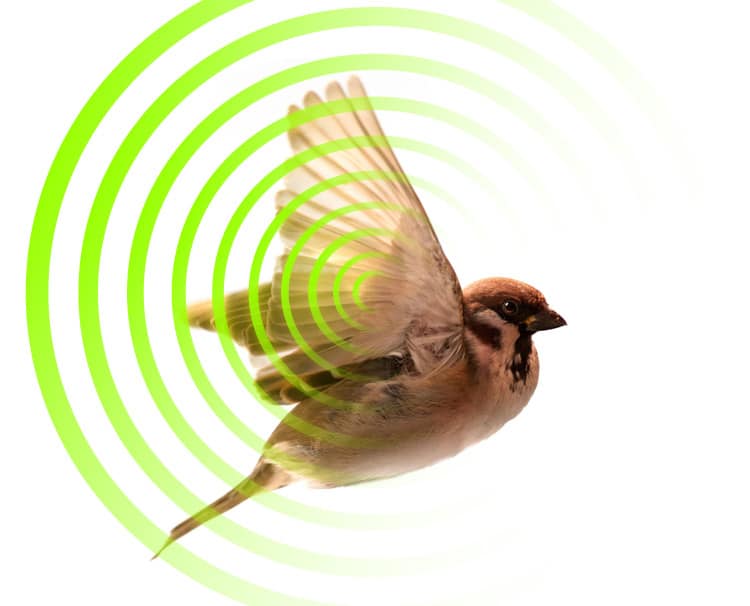Your cart is currently empty!

Disappearing Bees & Birds: Environmental Effects of EMF Radiation
Last Updated on October 7, 2023

Being human, it’s easy to forget that we are entirely dependent on our environment and the many forms of life within it.
After all, we are (as far as we know) the most intelligent species around, and we’ve used this brainpower to exert a lot of control on our surroundings.
Yet underneath all the progress that civilization has made, we are still subject to the workings of nature.
One of the best examples of this interdependence is honeybees.
Bees are relatively small and often unappreciated animals, but they do a whole lot for us. Through their daily buzzing from flower to flower, bees ensure the survival of 90 percent of the world’s wild plants and more than 30 percent of the food crops we eat (apples, citrus fruits, berries, onions, broccoli, almonds, and avocados, to name a few). And of course, we can’t forget about the honey they tirelessly produce. According to USDA reports, in 2017 2.7 million honey-producing colonies made 1.5 million pounds of raw honey.
Without bees, our dinner tables would be far less abundant!
In fact, we seem to be heading in the direction of just that–in the past decade, honeybee colonies have started to die off at alarming rates. Bees are leaving their hives en masse but fail to return home, seemingly disappearing.
This pattern has been termed Colony Collapse Disorder (CCD), and has never been previously observed in nature. It’s estimated that about a third of all colonies in the US have ceased to exist, leaving the number of total hives at its lowest in 50 years.
How EMFs May be Affecting Bees
Why this is happening is not fully understood, but it’s certain that there are several environmental factors contributing to the danger that our pollinating friends are in.
Climate change, widespread use of pesticides and genetically modified crops, and habitat change/loss all play a role. There is also mounting evidence that the global adoption of EMF (Electromagnetic Field) radiation-emitting wireless technology is partially to blame.
A study completed in Switzerland in 2017 examined the effects of EMF on bee behavior. Instead of placing phones inside the hives, independent researcher Daniel Favre amplified already-present ambient EMF and focused it on the chosen test colonies. Favre found that within an hour of exposure, the bees within these hives began to emit something called a “piping signal,” a higher-frequency sound made by the bees’ wings when they are agitated or in swarming mode. He also remarked that he was “attacked by furious honeybees when a second experiment was performed at a week interval on the same hive”.
Further evidence comes from this German study, published in 2006, in which researchers placed the base stations of cordless phones (which continuously send out pulsed wireless signals) beneath the honeycombs of 4 beehives. Compared to the control group hives whom were left undisturbed, those given the base stations showed significantly slower progression in honeycomb production (both in weight and area). Just as with the 2011 study mentioned above, bees from the irradiated colonies were much slower to return to their hives, if they returned at all.
Clearly, EMFs affect honeybees in a big way. Why is it that these tiny insects are so sensitive to electromagnetic radiation? The answer has to do with their physiology. Bees partially rely on the earth’s magnetic field for both intraspecific (within hive) and interspecific (plant-pollinator) communication.
The increasing presence of wireless signal, constantly traveling through our atmosphere, interferes with the bees’ abilities to accurately pick up on the more subtle electromagnetic fields naturally given off by our planet. This negatively affects their ability to orient themselves, navigate, and search for food, thereby potentially compromising their overall well-being and chances of survival.
But the effects of EMF radiation span beyond just the bees’ health and well-being, but to their role within the wider ecosystem. A 2023 study found that EMFs impact the pollination behavior of bees, which is cause for concern due to the importance of bees to the global food supply.
Birds Are Feeling the Effects from EMFs Too

Bees aren’t the only lifeforms that utilize magnetoreception—monarch butterflies, bats, and migratory birds all use this form of sensing as well. Thus, they are all likely to be disturbed by increasing levels of EMFs.
In fact, this has already found to be true in the case of birds.
A 2008 laboratory study focused on the effects of cell phone signal on fertile chicken eggs. The exposed groups of eggs were in close proximity to a phone that was set up to call a ten-digit number every three minutes throughout the incubation period; the mortality rate was significantly higher for these groups compared to the unexposed embryos.
This Spanish study tracked house sparrow population from 2002 to 2006 to test the hypothesis that EMFs were causing their decline. Sparrow counts and measurements of EMF strength were taken in thirty different urban areas, and researchers found that (aside from an overall decrease in house sparrow numbers over time) areas with high-strength electromagnetic fields had noticeably lower population densities.
These are only two of 26 different bird-focused studies reviewed here. Of all these, seventy percent discovered a positive correlation between EMF and either changes in bird behavior or negative health outcomes.
What Does This Mean for Humans?
In turn, the effects of EMFs on animals will have a ripple-effect on the rest of the planet. These creatures are all responsible for perpetuating various edible plants, either through the process of pollination or by spreading seeds to distant locations.
Though we may not be conscious of it most of the time, we rely heavily on them for the food we eat. They keep our plant life diverse and thriving.
If these vital members of the earth’s ecosystem begin to disappear, our world will change in ways we cannot fully imagine. The only prediction we can be certain about is that it won’t be a change for the better.
The increasingly-clear connection between EMF radiation and harm to non-human species speaks volumes—it seems the potential for this technology to cause harm reaches far beyond the scope of human life.
This shows us a distressing truth: that even when EMFs aren’t impacting our health directly, they are influencing our world in serious ways.
Wireless technology will only continue to become more prolific, which is all the more reason to be mindful of the way we use our devices and seek to reduce its risk for damage whenever possible. At this point, it seems like the only option we have.
Related Posts
None found























































